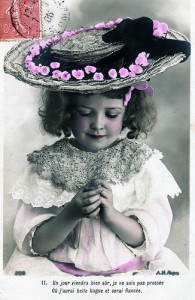The most striking thing to me about this poem are the images that suggest being clothed/covered/dressed in one’s legacy; or, in the poet’s words, that imply “wear[ing a] name” (line 1) that’s been passed between generations. There’s the “two carat diamond / which, like a heavy rock of salt, / falls to the side between […] fingers” (2-4) an image that suggests the precious nature of a heritage which doesn’t quite fit. There’s the grandmother’s* “skin loose / like pie crust draping over apples” (8-9); this skin, like the art of baking an apple pie, is something that’s passed between parent and child. There’s “the green sequined dress / [the poet’s grandmother] wore to the country club” (14-5), which looked “like a waterfall of thin emeralds” (16). This bejeweled garment becomes at once symbolic of the need to fit into one’s legacy, but doing it in our own way, even when others–including parents or spouse–may suggest otherwise. There’s the “bed [that will] soon be empty, / the electric blanket smooth / over her place” (20-2), both objects that, like the warmth of the woman’s legacy, provide some degree of comfort to the poet. And finally, there are “the reading glasses on the [bed] table” (23), suggestive that this mother has left behind a particular way of reading the world, one inherently captured in the poet’s life and stories.
Indeed, the confluence of these flowing images of fabric, jewelry, apple pies, skin, occurs in line ten, where the poet laments, “I want her to wake up and tell me stories.” Narrative, in whatever shape and form, is the way we order the world. It’s really what makes us human: we use words to tell stories, to gather our beloved around us, to draw them near. And it’s the structure of language, the subtle connections between words–rhythms, rhymes, spacing, etc.–that holds this poem together, I think, because in all its elegiac longing, the thing that keeps it from spinning into unrestrained grief at the poet’s potential loss are its subtle internal rhymes, its alliteration, its meter.
And these connections, I think, are what drive me back to poetry, to narrative, to language. They’re the things that hold us together even as we threaten, in the face of the postmodern loss of faith in language, to spin out of control. There is power in language to bind us beyond words. And this is part of our human inheritance. I believe that.
I really do.
——————–
*I’m reading this as a grandchild sitting with her grandmother because that’s what the images, the tone, and the words suggest to me. It could just as easily be a child sitting with her mother. Either reading, I think, is productive.

